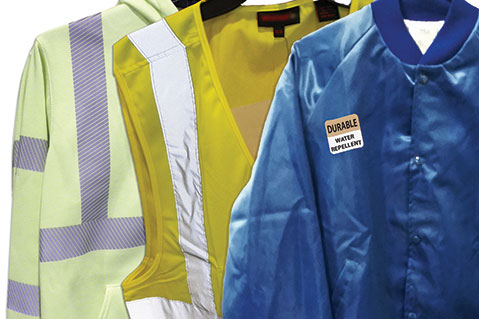Awards July 06, 2016
How to Decorate Workwear
Uniforms and workwear require different types of ink to screen print properly.
The materials and requirements of uniforms or workwear can vary significantly. A screen-printing shop that makes workwear part of the list of product offerings needs to be prepared to adapt to the different needs of each type of garment. Using the right ink and being aware of the limitations of various inks when it comes to laundering or various materials when it comes to heat can help ensure a better outcome for the print.

One category of workwear is industrial-style uniforms, which may be polyester, cotton or a 50/50 blend. Many uniforms will require industrial laundering, which means laundering under very high temperatures and drying under very high heat. Uniforms undergoing an industrial wash and dry won’t be good candidates for standard plastisol inks. Most garments of this type would either use a screen-printed emblem or be printed with a solvent-type ink system. If the garment is a uniform but won’t be subjected to an industrial wash and dry, inks like low-bleed plastisol (for 50/50 garments) and inks designed for polyester may be used.
Workwear for outdoor workers presents different challenges. Most sweatshirts worn as workwear will be 50/50 blends or 100% polyester. For 50/50 blends, a good low-bleed ink printed through the proper mesh count with just enough pressure to lay down the ink should be sufficient and create a long-lasting print.
A 100% polyester garment, on the other hand, can present unique issues. When printing on 100% poly, the biggest issue is bleed or dye migration. One cure for this issue would be to use a low-bleed ink. This will help stop the dye migration and keep the ink from turning the color of the garment. The dye migration can take up to 24 hours to occur, so always do a test print to make sure the problem has been stopped before printing a production run. Polyester jackets will also require a similar process.
Safety workwear is another category that requires special handling when being printed. One issue unique to safety workwear is whether or not reflective ink needs to be used. Often, safety workwear comes with reflective tape applied during the manufacturing process. More and more companies that use safety wear, like EMTs, police or firefighters, request reflective logos or other prints on their safety garments.
Reflective ink is usually either a water-based or plastisol-based product and generally uses a coupler to ensure that the reflective bead is locked into the ink film when fully cured, but will most likely not meet government specs for reflectivity standards, and so shouldn’t be the only source of reflectivity on the garment. Use a light hand when printing reflective ink. One flood stroke and one print stroke should do the job nicely.
If workwear is a staple order for any of your customers, it’s also wise to ensure that your apparel decorator has the following products on hand:
Stretch additive: This will allow inks greater stretch.
Low-cure additive: A product which allows ink to cure at slightly lower temperatures, reducing bleed and helping with shrinkage.
Low-bleed reducer: If an ink needs to be reduced, use low-bleed reducer to help with the bleed.
